Numpy Transpose Axis
NumPy is a powerful library for numerical computing in Python, and one of its most useful features is the ability to manipulate array dimensions through transposition and axis reordering. The transpose operation and axis manipulation functions in NumPy allow you to reshape and reorganize multidimensional arrays efficiently, which is crucial for many data processing and scientific computing tasks. In this comprehensive guide, we’ll explore the various methods and techniques for transposing and manipulating axes in NumPy arrays.
1. Introduction to NumPy Arrays and Axes
Before diving into transposition and axis manipulation, it’s essential to understand the concept of axes in NumPy arrays. In NumPy, an axis refers to a dimension of an array. For example, a 1D array has one axis, a 2D array has two axes, and so on. The number of axes in an array is equal to its dimensionality.
Let’s start with a simple example to illustrate the concept of axes:
import numpy as np
# Create a 2D array
arr = np.array([[1, 2, 3],
[4, 5, 6]])
print("Original array:")
print(arr)
print("Shape:", arr.shape)
print("Number of axes:", arr.ndim)
print("Size of each axis:", [arr.shape[i] for i in range(arr.ndim)])
Output:

In this example, we create a 2D array with two rows and three columns. The array has two axes: axis 0 (rows) and axis 1 (columns). The shape attribute gives us the size of each axis, while ndim tells us the number of axes.
2. Basic Transposition with numpy.transpose()
The most straightforward way to transpose an array in NumPy is by using the numpy.transpose() function or the T attribute of an array. Transposition swaps the axes of an array, effectively rotating it.
Let’s look at an example:
import numpy as np
# Create a 2D array
arr = np.array([[1, 2, 3],
[4, 5, 6]])
print("Original array:")
print(arr)
# Transpose the array
transposed = np.transpose(arr)
print("\nTransposed array:")
print(transposed)
# Using the T attribute
print("\nTransposed array using T attribute:")
print(arr.T)
print("\nShape of original array:", arr.shape)
print("Shape of transposed array:", transposed.shape)
Output:
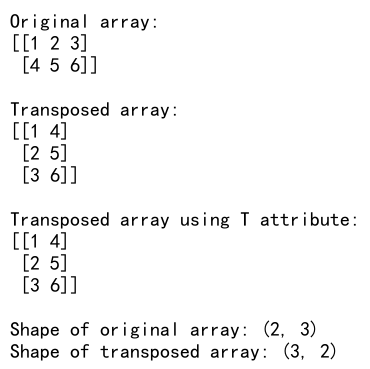
In this example, we create a 2D array and transpose it using both np.transpose() and the T attribute. The transposed array has its rows and columns swapped, and the shape is reversed.
3. Transposing Higher-Dimensional Arrays
Transposition becomes more interesting and powerful when dealing with higher-dimensional arrays. Let’s explore how to transpose 3D and 4D arrays:
import numpy as np
# Create a 3D array
arr_3d = np.array([[[1, 2], [3, 4]],
[[5, 6], [7, 8]]])
print("Original 3D array:")
print(arr_3d)
print("Shape:", arr_3d.shape)
# Transpose the 3D array
transposed_3d = np.transpose(arr_3d)
print("\nTransposed 3D array:")
print(transposed_3d)
print("Shape:", transposed_3d.shape)
# Create a 4D array
arr_4d = np.array([[[[1, 2], [3, 4]],
[[5, 6], [7, 8]]],
[[[9, 10], [11, 12]],
[[13, 14], [15, 16]]]])
print("\nOriginal 4D array:")
print(arr_4d)
print("Shape:", arr_4d.shape)
# Transpose the 4D array
transposed_4d = np.transpose(arr_4d)
print("\nTransposed 4D array:")
print(transposed_4d)
print("Shape:", transposed_4d.shape)
Output:

In this example, we create 3D and 4D arrays and transpose them. Notice how the shape of the arrays changes after transposition. For higher-dimensional arrays, transposition reverses the order of all axes.
4. Specifying Axis Order in numpy.transpose()
The numpy.transpose() function allows you to specify the desired order of axes explicitly. This is particularly useful when you want to reorder the axes in a specific way, rather than simply reversing them.
Here’s an example:
import numpy as np
# Create a 3D array
arr = np.array([[[1, 2], [3, 4]],
[[5, 6], [7, 8]]])
print("Original array:")
print(arr)
print("Shape:", arr.shape)
# Transpose with custom axis order
transposed = np.transpose(arr, axes=(2, 0, 1))
print("\nTransposed array:")
print(transposed)
print("Shape:", transposed.shape)
# Another example with a different axis order
transposed2 = np.transpose(arr, axes=(1, 2, 0))
print("\nTransposed array (2nd example):")
print(transposed2)
print("Shape:", transposed2.shape)
Output:

In this example, we create a 3D array and transpose it using custom axis orders. The axes parameter in np.transpose() allows us to specify the new order of axes. This gives us fine-grained control over how we want to reshape our array.
5. Using numpy.swapaxes() for Pairwise Axis Swapping
While numpy.transpose() is versatile, sometimes you only need to swap two specific axes. For this purpose, NumPy provides the numpy.swapaxes() function, which allows you to swap two axes of an array.
Let’s see how it works:
import numpy as np
# Create a 3D array
arr = np.array([[[1, 2], [3, 4]],
[[5, 6], [7, 8]]])
print("Original array:")
print(arr)
print("Shape:", arr.shape)
# Swap axes 0 and 2
swapped = np.swapaxes(arr, 0, 2)
print("\nArray with axes 0 and 2 swapped:")
print(swapped)
print("Shape:", swapped.shape)
# Swap axes 1 and 2
swapped2 = np.swapaxes(arr, 1, 2)
print("\nArray with axes 1 and 2 swapped:")
print(swapped2)
print("Shape:", swapped2.shape)
Output:

In this example, we use np.swapaxes() to swap different pairs of axes in a 3D array. This function is particularly useful when you need to make a specific change to the array’s structure without affecting other axes.
6. Reshaping Arrays with numpy.reshape()
While not strictly a transposition operation, reshaping arrays is closely related to axis manipulation. The numpy.reshape() function allows you to change the shape of an array while preserving its data.
Here’s an example of reshaping arrays:
import numpy as np
# Create a 1D array
arr = np.arange(12)
print("Original array:")
print(arr)
print("Shape:", arr.shape)
# Reshape to 2D
reshaped_2d = arr.reshape(3, 4)
print("\nReshaped to 2D:")
print(reshaped_2d)
print("Shape:", reshaped_2d.shape)
# Reshape to 3D
reshaped_3d = arr.reshape(2, 3, 2)
print("\nReshaped to 3D:")
print(reshaped_3d)
print("Shape:", reshaped_3d.shape)
# Using -1 for automatic dimension calculation
reshaped_auto = arr.reshape(-1, 3)
print("\nReshaped with automatic dimension:")
print(reshaped_auto)
print("Shape:", reshaped_auto.shape)
Output:

In this example, we reshape a 1D array into various 2D and 3D configurations. The -1 parameter in reshape() tells NumPy to automatically calculate the size of that dimension based on the array’s total size and the other specified dimensions.
7. Expanding Dimensions with numpy.expand_dims()
Sometimes you need to add a new axis to an array, effectively increasing its dimensionality. The numpy.expand_dims() function allows you to insert a new axis at a specified position.
Let’s see how it works:
import numpy as np
# Create a 2D array
arr = np.array([[1, 2, 3],
[4, 5, 6]])
print("Original array:")
print(arr)
print("Shape:", arr.shape)
# Expand dimensions along axis 0
expanded_0 = np.expand_dims(arr, axis=0)
print("\nExpanded along axis 0:")
print(expanded_0)
print("Shape:", expanded_0.shape)
# Expand dimensions along axis 1
expanded_1 = np.expand_dims(arr, axis=1)
print("\nExpanded along axis 1:")
print(expanded_1)
print("Shape:", expanded_1.shape)
# Expand dimensions along axis 2
expanded_2 = np.expand_dims(arr, axis=2)
print("\nExpanded along axis 2:")
print(expanded_2)
print("Shape:", expanded_2.shape)
Output:
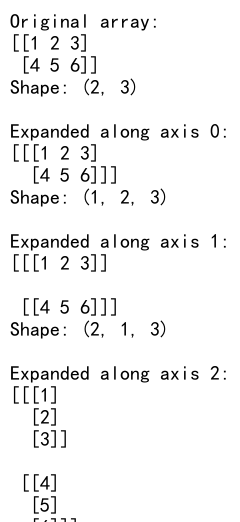
In this example, we add new axes to a 2D array at different positions. This operation is useful when you need to broadcast an array or align dimensions for operations with other arrays.
8. Squeezing Arrays with numpy.squeeze()
The opposite of expanding dimensions is squeezing them out. The numpy.squeeze() function removes axes of length one from an array.
Here’s an example:
import numpy as np
# Create an array with some singleton dimensions
arr = np.array([[[1], [2], [3]]])
print("Original array:")
print(arr)
print("Shape:", arr.shape)
# Squeeze the array
squeezed = np.squeeze(arr)
print("\nSqueezed array:")
print(squeezed)
print("Shape:", squeezed.shape)
# Create another array with multiple singleton dimensions
arr2 = np.array([[[[1]]], [[[2]]], [[[3]]]])
print("\nAnother array with singleton dimensions:")
print(arr2)
print("Shape:", arr2.shape)
# Squeeze specific axes
squeezed2 = np.squeeze(arr2, axis=(1, 2))
print("\nSqueezed array (specific axes):")
print(squeezed2)
print("Shape:", squeezed2.shape)
Output:
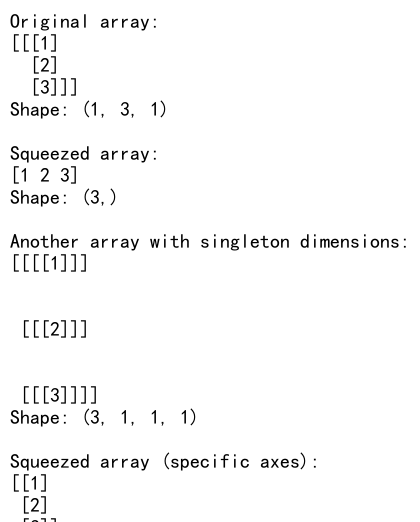
In this example, we remove singleton dimensions from arrays using np.squeeze(). This function is useful for simplifying the structure of arrays that have unnecessary length-one axes.
9. Rearranging Array Elements with numpy.moveaxis()
The numpy.moveaxis() function allows you to move axes of an array to new positions, effectively rearranging the dimensions of the array.
Let’s see how it works:
import numpy as np
# Create a 3D array
arr = np.array([[[1, 2], [3, 4]],
[[5, 6], [7, 8]]])
print("Original array:")
print(arr)
print("Shape:", arr.shape)
# Move axis 0 to position 2
moved = np.moveaxis(arr, 0, 2)
print("\nArray with axis 0 moved to position 2:")
print(moved)
print("Shape:", moved.shape)
# Move axis 2 to position 0
moved2 = np.moveaxis(arr, 2, 0)
print("\nArray with axis 2 moved to position 0:")
print(moved2)
print("Shape:", moved2.shape)
# Move multiple axes
moved3 = np.moveaxis(arr, [0, 1], [2, 0])
print("\nArray with multiple axes moved:")
print(moved3)
print("Shape:", moved3.shape)
Output:
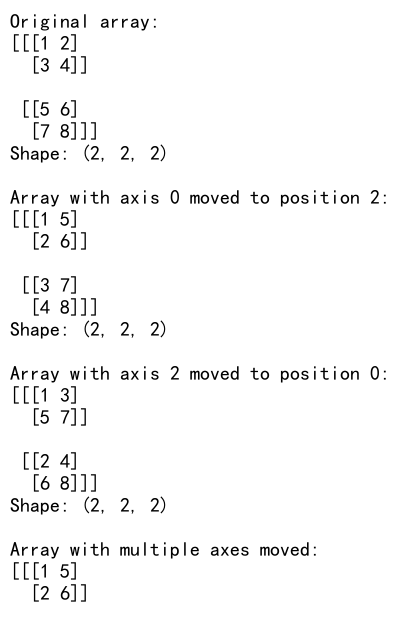
In this example, we use np.moveaxis() to rearrange the axes of a 3D array in various ways. This function provides a flexible way to reorder dimensions without explicitly specifying the entire axis order.
10. Transposing Parts of an Array with numpy.transpose()
Sometimes you may want to transpose only a part of an array, leaving other dimensions unchanged. You can achieve this by combining numpy.transpose() with other array manipulation techniques.
Here’s an example:
import numpy as np
# Create a 4D array
arr = np.array([[[[1, 2], [3, 4]],
[[5, 6], [7, 8]]],
[[[9, 10], [11, 12]],
[[13, 14], [15, 16]]]])
print("Original array:")
print(arr)
print("Shape:", arr.shape)
# Transpose the last two dimensions
transposed = np.transpose(arr, axes=(0, 1, 3, 2))
print("\nArray with last two dimensions transposed:")
print(transposed)
print("Shape:", transposed.shape)
# Transpose the middle two dimensions
transposed2 = np.transpose(arr, axes=(0, 2, 1, 3))
print("\nArray with middle two dimensions transposed:")
print(transposed2)
print("Shape:", transposed2.shape)
Output:
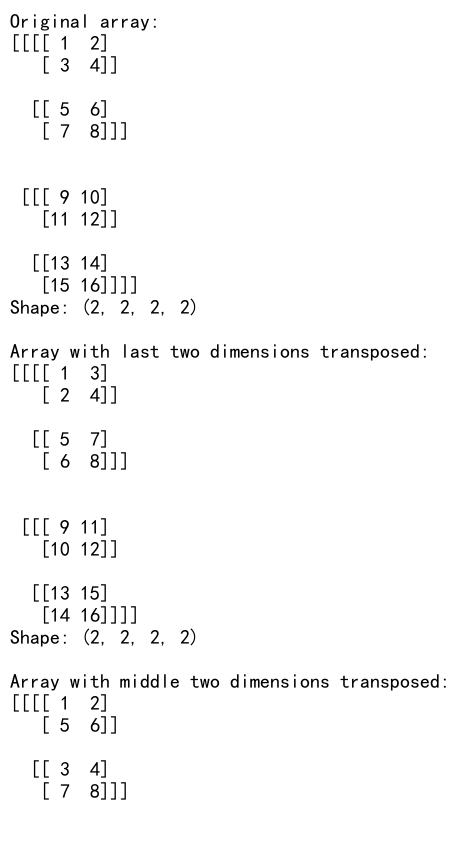
In this example, we transpose specific parts of a 4D array by carefully specifying the axis order in np.transpose(). This technique allows for fine-grained control over which dimensions are affected by the transposition.
11. Broadcasting and Axis Manipulation
Broadcasting is a powerful feature in NumPy that allows arrays with different shapes to be used in arithmetic operations. Understanding how broadcasting interacts with axis manipulation is crucial for efficient array operations.
Let’s explore an example:
import numpy as np
# Create a 2D array
arr_2d = np.array([[1, 2, 3],
[4, 5, 6]])
# Create a 1D array
arr_1d = np.array([10, 20, 30])
print("2D array:")
print(arr_2d)
print("\n1D array:")
print(arr_1d)
# Broadcasting addition
result = arr_2d + arr_1d
print("\nResult of broadcasting addition:")
print(result)
# Transpose 2D array and try broadcasting
transposed_2d = np.transpose(arr_2d)
try:
result2 = transposed_2d + arr_1d
except ValueError as e:
print("\nError when adding transposed 2D array and 1D array:")
print(str(e))
# Reshape 1D array for broadcasting with transposed 2D array
reshaped_1d = arr_1d.reshape(-1, 1)
result3 = transposed_2d + reshaped_1d
print("\nResult of broadcasting addition with reshaped 1D array:")
print(result3)
Output:
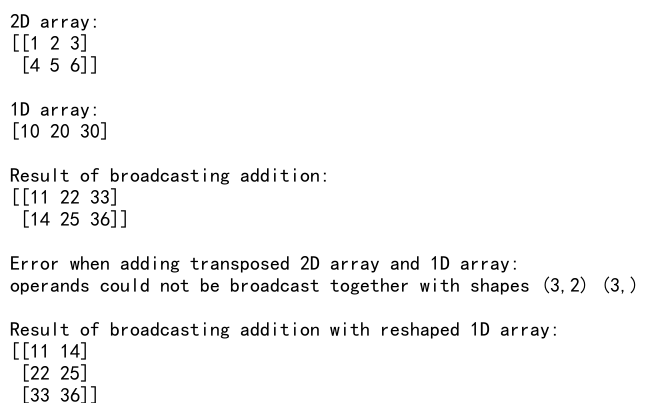
In this example, we demonstrate how transposition and reshaping affect broadcasting operations. Understanding these interactions is crucial for writing efficient and correct NumPy code.
12. Performance Considerations in Axis Manipulation
When working with large arrays, the performance of axis manipulation operations becomes crucial. Some operations, like transposition, can be quite efficient, while others may involve data copying and can be more time-consuming.
Let’s compare the performance of different axis manipulation techniques:
import numpy as np
import time
# Create a large 3D array
arr = np.random.rand(1000, 1000, 3)
# Measure time for np.transpose()
start = time.time()
transposed = np.transpose(arr, axes=(2, 0, 1))
end = time.time()
print(f"Time taken for np.transpose(): {end - start:.6f} seconds")
# Measure time for arr.T
start = time.time()
transposed2 = arr.T
end = time.time()
print(f"Time taken for arr.T: {end - start:.6f} seconds")
# Measure time for np.swapaxes()
start = time.time()
swapped = np.swapaxes(arr, 0, 2)
end = time.time()
print(f"Time taken for np.swapaxes(): {end - start:.6f} seconds")
# Measure time for np.moveaxis()
start = time.time()
moved = np.moveaxis(arr,[0, 1, 2], [2, 0, 1])
end = time.time()
print(f"Time taken for np.moveaxis(): {end - start:.6f} seconds")
# Measure time for np.reshape()
start = time.time()
reshaped = arr.reshape(3, 1000, 1000)
end = time.time()
print(f"Time taken for np.reshape(): {end - start:.6f} seconds")
Output:

In this example, we compare the performance of various axis manipulation techniques on a large 3D array. The results may vary depending on your hardware and NumPy version, but generally, arr.T and np.transpose() are quite efficient for simple transpositions, while np.reshape() can be slower if it requires data copying.
13. Axis Manipulation in Data Analysis Tasks
Axis manipulation is crucial in data analysis tasks, especially when working with pandas DataFrames that are built on top of NumPy arrays. Let’s look at an example of how axis manipulation can be used in a data analysis scenario:
import numpy as np
import pandas as pd
# Create a sample dataset
data = np.array([
[1, 2, 3, 4],
[5, 6, 7, 8],
[9, 10, 11, 12]
])
df = pd.DataFrame(data, columns=['A', 'B', 'C', 'D'])
print("Original DataFrame:")
print(df)
# Transpose the DataFrame
df_transposed = df.T
print("\nTransposed DataFrame:")
print(df_transposed)
# Calculate column-wise mean
col_mean = np.mean(data, axis=0)
print("\nColumn-wise mean:")
print(col_mean)
# Calculate row-wise mean
row_mean = np.mean(data, axis=1)
print("\nRow-wise mean:")
print(row_mean)
# Add a new dimension for broadcasting
col_mean_expanded = np.expand_dims(col_mean, axis=0)
row_mean_expanded = np.expand_dims(row_mean, axis=1)
# Subtract means from the original data
data_centered_cols = data - col_mean_expanded
data_centered_rows = data - row_mean_expanded
print("\nData centered by columns:")
print(data_centered_cols)
print("\nData centered by rows:")
print(data_centered_rows)
Output:

In this example, we demonstrate how axis manipulation can be used in common data analysis tasks such as transposing data, calculating means along different axes, and centering data.
14. Handling Missing Data with Axis Manipulation
When dealing with missing data, axis manipulation can be useful for operations like dropping rows or columns with missing values. Let’s explore an example:
import numpy as np
import pandas as pd
# Create a sample dataset with missing values
data = np.array([
[1, 2, np.nan, 4],
[5, np.nan, 7, 8],
[9, 10, 11, np.nan]
])
df = pd.DataFrame(data, columns=['A', 'B', 'C', 'D'])
print("Original DataFrame with missing values:")
print(df)
# Drop rows with any missing values
df_dropped_rows = df.dropna()
print("\nDataFrame with rows containing missing values dropped:")
print(df_dropped_rows)
# Drop columns with any missing values
df_dropped_cols = df.dropna(axis=1)
print("\nDataFrame with columns containing missing values dropped:")
print(df_dropped_cols)
# Fill missing values with column means
col_means = np.nanmean(data, axis=0)
data_filled = np.where(np.isnan(data), col_means, data)
df_filled = pd.DataFrame(data_filled, columns=['A', 'B', 'C', 'D'])
print("\nDataFrame with missing values filled by column means:")
print(df_filled)
Output:
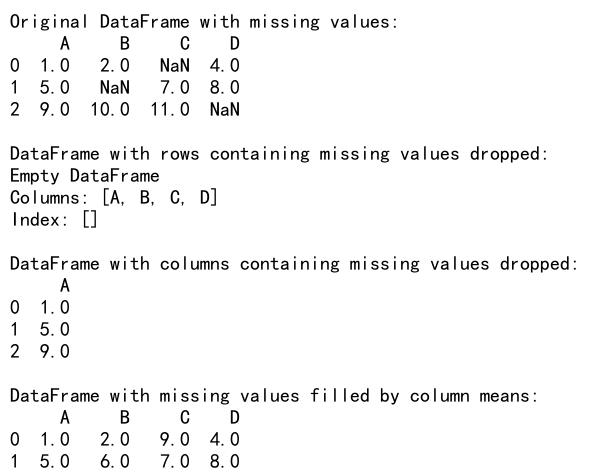
In this example, we demonstrate how axis manipulation can be used to handle missing data, including dropping rows or columns with missing values and filling missing values with column means.
15. Axis Manipulation in Image Processing
Image processing is another area where axis manipulation is frequently used. Let’s look at an example of how transposition and axis manipulation can be applied to image data:
import numpy as np
import matplotlib.pyplot as plt
# Create a sample 3-channel image
image = np.random.rand(100, 100, 3)
print("Original image shape:", image.shape)
# Display the original image
plt.figure(figsize=(10, 5))
plt.subplot(1, 3, 1)
plt.imshow(image)
plt.title("Original Image")
# Transpose the image to swap height and width
image_transposed = np.transpose(image, (1, 0, 2))
print("Transposed image shape:", image_transposed.shape)
# Display the transposed image
plt.subplot(1, 3, 2)
plt.imshow(image_transposed)
plt.title("Transposed Image")
# Swap color channels
image_channel_swapped = np.transpose(image, (0, 1, 2))[:, :, ::-1]
print("Channel-swapped image shape:", image_channel_swapped.shape)
# Display the channel-swapped image
plt.subplot(1, 3, 3)
plt.imshow(image_channel_swapped)
plt.title("Channel-swapped Image")
plt.tight_layout()
plt.show()
Output:

In this example, we demonstrate how axis manipulation can be used to transpose an image (effectively rotating it) and swap color channels. These operations are common in image processing tasks.
16. Numpy Transpose Axis Conclusion
Axis manipulation is a fundamental skill in NumPy and is essential for efficient data processing, scientific computing, and machine learning tasks. We’ve covered a wide range of techniques and applications, from basic transposition to complex reshaping operations used in neural networks and data analysis.
Key takeaways include:
- Understanding the concept of axes in NumPy arrays is crucial for effective manipulation.
numpy.transpose()and theTattribute provide simple ways to transpose arrays.- Functions like
numpy.swapaxes(),numpy.moveaxis(), andnumpy.reshape()offer more fine-grained control over array dimensions. - Axis manipulation is closely tied to broadcasting, which is essential for efficient array operations.
- Performance considerations are important when working with large arrays.
- Axis manipulation is widely used in various domains, including matrix operations, neural networks, data analysis, image processing, and time series analysis.
By mastering these techniques, you’ll be well-equipped to handle a wide variety of data manipulation tasks efficiently using NumPy. Remember to always consider the shape and dimensions of your arrays when performing operations, and use the appropriate axis manipulation functions to achieve your desired results.